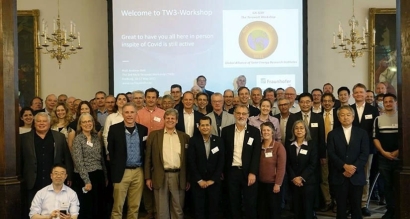
In the spring of this year, the one terawatt (TW) mark of installed PV capacity was surpassed, marking a major milestone for solar energy. However, there is still much more to come, and an acceleration of industrial production and deployment is in sight.
"This exponential growth towards a multi-terawatt market presents enormous opportunities as well as challenges for the industry and research communities. They affect all steps of the value chain, from product design to material procurement and recycling," explained Prof. Dr. Andreas Bett, head of Fraunhofer ISE.
With solar energy playing a central role in the future global energy system, the challenges and opportunities for complementary technologies, such as energy storage, grid integration, power to gas/liquids, and multiple sector electrification, are also increasing. Research spanning materials science, module design, systems reliability, product integration, and manufacturing will be required to pave the way to multi-TW-scale PV deployment.
During the workshop, participants discussed PV technologies for the multi-TW era and the role of sector coupling, which increases the demands of solar electricity further and will open new markets and options to integrate PV into the energy system at the TW scale.
Another key topic was the issue of material availability, as well as the question of a multi-TW value and supply chain. Workshop participants agreed that the increased production will bring a new set of R&D challenges to the scientific community. Targeted R&D is needed to reduce silver use, and product design for recycling of semiconductors, metals, and glass will be crucial for the long-term sustainability of the PV industry. The group believes that a sense of renewed urgency is required to couple rapid deployment and associated R&D.
"Waiting for future solutions is not an option," said Nancy Haegel, center director of the Materials Science Center at NREL. "We must act now to reduce CO2 emissions, and solar energy is ready today to ramp up rapidly and meet that challenge."
NREL is a national laboratory managed and operated by the Alliance for Sustainable Energy, LLC, for the United States Department of Energy (DOE). Integral to its mission for the DOE, NREL conducts R&D in renewable energy and energy efficiency technologies and practices, advances related science and engineering, and transfers knowledge and innovation to address the United States' energy and environmental goals. NREL is supported by funding from the DOE Office of Energy Efficiency and Renewable Energy (EERE). Within the PV programs, researchers support the development of new designs and manufacturing processes for solar materials, components, and systems, with an emphasis on improved performance, reliability, and service life. Long-term R&D is an essential element for cost reduction, improved reliability, and improved performance of technologies currently supported by the Solar Energy Technologies Program at DOE. NREL's long-term R&D activities include the development of advanced materials and designs for next-generation solar PV devices. Collaborative activities among the world's foremost players in the field of solar energy research from Germany, Japan, and the United States will lead to a significant acceleration of progress in these fields. Learn more at www.nrel.gov.
AIST is one of the largest public research organizations in Japan. AIST focuses on the creation and practical realization of technologies useful to Japanese industry and society and on bridging the gap between innovative technological seeds and commercialization. Among five departments and two centers, AIST has the Energy and Environment Department, which works to promote green innovation through the development of related technologies, including renewable energy, storage, power electronics, and grid integration. PV research is conducted in the department. More information can be found at https://www.aist.go.jp/index_en.html.
With a staff of close to 1,400, the Fraunhofer ISE in Freiburg, Germany, is the largest solar energy research institute in Europe. Fraunhofer ISE is committed to promoting sustainable, economic, safe, and socially just energy supply systems based on renewable energy. Its research provides the technological foundation for supplying energy efficiently and on an environmentally sound basis in industrialized, threshold, and developing countries throughout the world. Focusing on energy efficiency, energy conversion, energy distribution, and energy storage, the institute develops materials, components, systems, and processes in five business areas. One particular feature of Fraunhofer ISE is its excellent technical infrastructure, which is organized into eight laboratory centers and four technology evaluation centers providing testing and experimental services on a production scale. In addition, the institute has several accredited testing facilities. The institute is a member of the Fraunhofer-Gesellschaft, Europe's largest application-oriented research organization. For more information, visit www.ise.fraunhofer.de.

